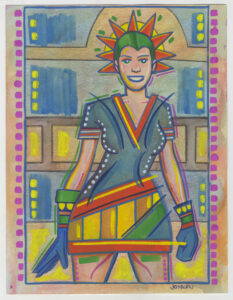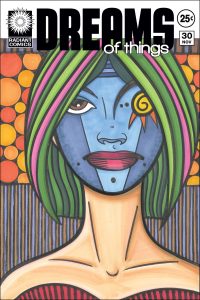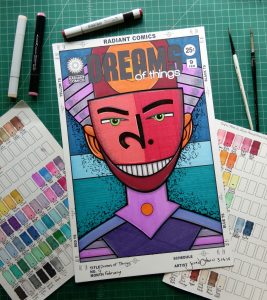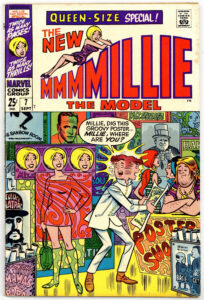Sometimes I have to stop and take stock of what art I’ve made over the last year or so. I’m generally pretty good at getting things done but part of the process is examining what I’ve done. If art is its own reward then I’d better take the time to contemplate that reward. Thinking about what I’ve done in the past helps me get more art made in the future.
So here are some of the things I’ve gotten done over this year.
Great Gatsby Illustrated Edition. I’ve been working on these illustrations all year. I have about 20 of them done and in the last month I was working on the book design and integrating the illustrations with the text. I still have more that I want to do so this project may take a while longer. It took me nine months to get to the design part of the project but I think it is working out. I was unhappy with it at first but now it’s going along well.
Dreams of Things covers to comic books that don’t exist. These are the 11×17 inch drawings that I make. I’m a fan of comic books and I especially like the concept of comic book theirs. They promise you worlds and stories inside the book and give you a glimpse of those worlds on the cover. That glimpse is what hooks you. It’s a promise of greater things to come. I like that idea and try to make my covers as intriguing and attractive as possible. I want to know more about the stories inside the nonexistent book!

Inkbook drawings. I’m always getting these done. I’ve been filling up my inkbooks for 22 years. I get a book a year done. 100 pages of small spontaneous ink drawings that I use to get a lot of my visual ideas form. Each page has from six to nine drawings on it and I draw two pages a week. Just this week I looked through book nine and picked out six small drawings to work on and make into “Dreams of Things” covers. It’s good to have a reservoir of images.
Web Comics. My Four Talking Boxes comic strip is the one I work on every day. Each day I write a new strip and once a week I assemble five strips. Over a dozen years ago I made character sheets for all six of my comic strip characters. I pull the drawings from those sheets and paste them into my written comic strip to using Adobe Illustrator. After all these years I’ve got it down and keep it going.
I also worked on my two weekly strips: “Message Tee” and “Drifting and Dreaming.” These two run on Saturday and Sunday and I got 52 of each done. I made 156 drawings for D&D in the first half of the year and put them into strips. For Message Tee I reused some of another year’s drawings and wrote new messages for the shirts. This strip is all about the messages so I don’t sweat the drawing too much.
Gouache Painting. Having just purchased a new group of gouache paints I’ve only finished one painting as of the writing of this but I plan to get more done in the future. I’m not sure exactly what they’re going to look like though. Maybe some small 5×7 inch paintings. We’ll have to see.
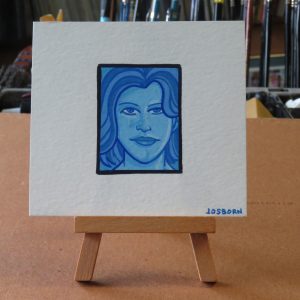
Color Ink drawings. This was 2021’s new style but I continued it into 2022. Back then I bought a bunch of color inks and figured out a way to draw with them. I continued to make color ink drawings and even did some of the Gatsby illustrations in color ink. I think I’m going to mix some color inks in with the gouache paintings and see how that goes. I think the two mediums will work well together.
Big Ink Drawings. I slowed down with these this year but I still made some of them. These are my black and white ink drawings that I make on 22×30 inch paper. I think the time I spent working on them in 2020 and 2021 got taken up by my Gatsby project this year but I have been thinking about making some big Gatsby drawings so maybe I’ll mix the two things. I find these big ink drawings satisfying so I have to get back to them.
Six by nine inch ink drawings. I’ve made a lot of these ones this year. I search through one of my inkbook for drawings that I like and then blow up and print out those little ink drawings, in blue line, on 6×9 inch paper. After that I tape the edges of the paper as a mask so I don’t have to stop my hand and the ink brush as I get to the border of the drawing. This makes the drawing easier to do. I draw away on top of the blue line drawing.
Tape Pull Videos. I mentioned the part about taping the edges of the drawings because after I’m done with the drawing I make a video of me pulling the tape off the drawing and post the video to Instagram. For some reason Instagram likes those videos and they get more views than anything else I post there.
The tape I use on the edges is Scotch Removable Tape. It’s a low tack tape that’s made to be temporary. I learned about it back in 1990 when I was working in the Marvel Bullpen. Before the era of desktop publishing we had to do things by hand with paper, tape, and glue. This removable tape was made for the jobs where something had to be temporarily in place so the tape was easy to remote and didn’t rip the paper when removing it as most tape does.
It’s satisfying to remove the tape and see the edges of the drawing become nice and clean. Where there once was an abundance of stray ink marks becomes a clean area before our eyes. Other people seem to find it satisfying too. That’s what they occasionally say in the comment section.
So there you go. That’s what I’ve had going on this year. I got some stuff done. Hopefully that will help me get more stuff done in the future.

